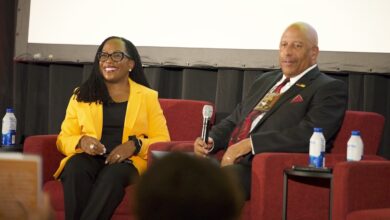
Source: LAist
When Humberto Estratalán’s daughter started transitional kindergarten last fall in the Coachella Valley city of La Quinta, he was surprised to hear she’d be in a combination class with kindergartners — with only one teacher.
He said the classroom held about 30 kids, but no dedicated aide to help the teacher manage them. His daughter would come home, deflated.
“She was struggling emotionally. We could tell she was just a little, not herself, not as happy to be at school,” Estratalán said. “She said, ‘Who do I go to when [the teacher] is busy?’”
The most upsetting moment was when he picked her up from school one day and noticed her sweatpants were inside out. He said when he asked the school about it, he was told his daughter had an accident and was sent to an office to change by herself.
“Here we have a 4-year-old in the office restroom, sitting on the floor, naked, changing herself,” he said. “That was the last straw.”
Estratalán, who is an education policy advocate for the nonprofit UNITE-LA, said he knew state rules require an adult for every 12 transitional kindergarten students. He complained to the Desert Sands Unified School District, and within two months the school reassigned teachers from other grades and hired more staff to open up a new transitional kindergarten class with a teacher and aide where he said his daughter is thriving.
The rough start of the year, however, highlights the staffing challenges some school districts face as they try to keep up with California’s rapid expansion of transitional kindergarten. The state needs a lot more teachers and aides to fill TK classrooms, but advocates say early childhood educators who have the experience and desire to step into those jobs are being deterred by the state’s credentialing system.
What is the teacher labor market for transitional kindergarten?
Starting this fall, any child who turns 4 by Sept. 1 can enroll in TK, marking the final phase of California’s four-year rollout of the new grade. There’s a lot riding on the success of universal TK: supporters hope that a year of learning through play will help give a boost to young kids who may not otherwise have access to preschool. Districts facing declining enrollment hope that a surge of new students will improve their financial outlook.
Gov. Gavin Newsom, who made universal TK a focus of his education policy, is proposing to spend $3.9 billion in the 2025-26 budget to fully implement the program. Part of that money would go toward lowering the student to teacher staffing ratio from from 12-to-1 to 10-to-1. School districts that don’t comply could face a fine or risk losing funding.
Researchers estimate that California schools will need 11,900 teachers and at least 16,000 aides to keep TK expansion on track. But amid a shortage of teachers at all levels of public education, some school districts struggle to hire or retain those who have the skills to support the physical, social-emotional and cognitive development of 4-year-olds, said Naj Alikhan, a spokesman for the Association of California School Administrators.
Rural or smaller school districts have a hard time finding a qualified teacher from their local pool of candidates.
Desert Sands Unified, where Estratalán’s daughter is enrolled, has hosted job fairs and offered financial incentives to entice teachers.
“We don’t have, you know, five universities like the Bay Area right around all these school districts, and it’s difficult,” said Dennis Zink, senior director of certificated personnel at the district.
Why aren’t teachers getting the needed credentials?
To grow the workforce, the state introduced a new credential for teachers who want to specialize in TK through third grade.
But Alikhan says he’s hearing anecdotally that not enough people are pursuing the credential, and one reason may be its stringent requirements.
“Teachers may want to do it, but it’s the investment of time and investment of money that’s preventing some from moving forward with it,” he said.
Candidates must hold a bachelor’s degree, complete coursework in child development or early childhood education, pass the state’s teacher performance assessment and undergo up to 600 hours of training in classrooms — typically without pay.
Critics say those are tough barriers for at least 17,000 early educators who already teach young kids and have a bachelor’s degree, but aren’t part of the state’s K-12 school system.
Angelica Cardenas, who has a master’s degree in early childhood education and 13 years of experience teaching 2- to 5-year-olds in Head Start and state preschool programs in the Bay Area, would still need a credential to teach TK.
“People tell me ‘I think you’d be a really good TK teacher,’ and I would love to, but right now I don’t know if I have the energy to go back to school,” Cardenas said.
What if you’re already a K-12 teacher?
The state’s credentialing program would also require her to jump through more hoops than a K-12 teacher at a private or public school with no experience teaching 4-year-olds.
For example, a preschool teacher with a bachelor’s degree and five years of work experience would still have to undergo classroom training to earn the credential. Those 600 hours amount to at least $10,000 in lost wages, according to researchers at the Center for the Study of Child Care Employment (CSCCE) at UC Berkeley and at the California Budget and Policy Center.
By comparison, private school teachers, who are not required to hold a state-issued credential, can shift to TK without additional training or any experience teaching 4-year-olds. State law only requires them and K-12 public school teachers to complete six to eight classes of early childhood education or development.
Lea Austin, executive director of the CSCCE, argues that the separate pathways are inequitable for early educators, the majority of whom are women of color. A preschool teacher earns on average $17.66 per hour, which is less than half the salary of an elementary school teacher, according to an analysis of the most recent labor data for California workers.
“You can’t use your existing experience and education as evidence that you are a qualified teacher in the same way that anybody teaching kindergarten or older has the opportunity to do that,” Austin said.
Austin and other advocates have called on the state’s Commission on Teacher Credentialing to offer early educators the same pathway to teaching TK as private school teachers. She said if the state doesn’t improve access, it risks losing a valuable workforce.
“It just feels sad and wrong to be losing such experienced educators when there’s a clear need for them and when there should be opportunities for them,” Austin said.
Mary Vixie Sandy, director of the commission, said that policy for private school teachers existed long before the PK-3 credential came along. She urged patience as teacher preparation programs train the first cohorts of PK-3 credential candidates to figure out what worked, what didn’t and consider changes in the future.
“We’re not trying to keep a workforce out, not at all. We most certainly want the workforce in,” she said.
What can teacher education programs do?
The CTC allows teacher training programs to waive up to 400 hours of training depending on a person’s preschool classroom experience, but requires 200 hours to prepare candidates to teach all the way up to third grade.
“The knowledge of someone whose complete experience has been with 3- and 4-year-olds may not be sufficient to be assigned to a third-grade classroom,” she said. “And if they have a credential that authorizes them to serve in those places, we have a fundamental obligation to the public to make sure the people we credential are prepared to do so.”
Cardenas, 38, considers herself a lifelong learner and said she would be willing to undergo more professional training, but she can’t afford to take time off work to pursue a credential, at least not without a scholarship or grant.
It takes one to two years to complete a teacher preparation program, and the CTC is giving these programs some leeway to waive prior coursework in child development or early childhood education.
The state has awarded millions of dollars in grants to support aspiring TK teachers willing to work in classrooms as they earn their credential. California State University, Dominguez Hills is offering up to $15,000 grants to students pursuing the credential as part of an effort to increase the early childhood education workforce. It’s also trying to make returning to school easier for preschool teachers who have an associate’s degree by giving them three years to complete their bachelor’s degree and PK-3 credential if they attend full-time.
San Jose State University is covering the full cost of tuition for early educators enrolled in its PK-3 credentialing program, according to Maria Fusaro, a child and adolescent development professor at the university.
Fusaro said going through the program takes “a big commitment,” but it’s up to early educators to decide whether the effort is worth the reward of working in a K-12 setting.
A single mom of two boys, Cardenas said she’s attracted to the good salary, benefits and summer breaks that come with teaching in public schools. She also said she was excited by the prospect of teaching TK when the state began expanding the grade.
She knows she has what it takes to teach 4-year-olds — the patience to see them through the potty training and other foundational skills so they’re ready for the next stage of learning.
“It saddens me that after all the years of education that I have, all the years of experience, I wouldn’t be able to teach TK even though that’s my jam,” she said.






